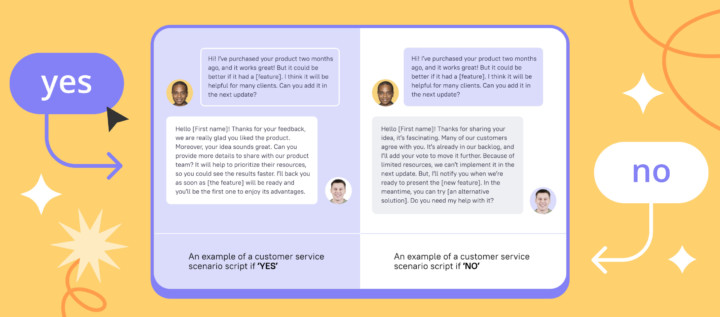What is product success? Understanding the key metrics and strategies

Introduction
In the realm of product development, understanding the nuances of product success is paramount for organizations aiming to thrive in a competitive landscape. Product success is not merely a measure of sales; it encompasses a holistic view that includes:
- Customer satisfaction
- Market fit
- Financial performance
As companies increasingly recognize the importance of aligning their offerings with customer needs, the integration of effective communication strategies becomes essential. With the rise of digital technologies and evolving consumer expectations, businesses must adapt by leveraging data-driven insights and fostering collaboration between customer success and product management teams.
This article delves into the critical concepts, metrics, and strategies that define product success, offering a roadmap for organizations looking to enhance their performance and secure a sustainable competitive advantage.
Defining product success: Key concepts and importance
Product success boils down to one thing: meeting or exceeding client expectations. If you can’t do that, you’re not going to make it. This isn’t just about delivering a product; it’s about understanding market fit, ensuring customer satisfaction, and hitting financial targets. Companies that prioritize these elements can carve out a growth path and stand out from the competition.
Look at the numbers:
- 84% of brands and marketers report positive results from their PPC advertising.
- That’s not just luck—it’s about effectively communicating value.
- According to LinkedIn, when people see brand messages, they’re six times more likely to convert.
That’s a game changer. If you want to succeed in the market, mastering communication is essential. And let’s not forget customer satisfaction. Happy customers lead to repeat business and loyalty, which are critical for long-term success.
Now, consider the high performers. They’re not just getting by; they’re moving fast. These companies complete their development cycles 20%-25% quicker than their peers. Why? Because efficiency in innovation is key to product success. Companies that can innovate quickly are better positioned to adapt to market changes and drive sustainable success.
Looking ahead, keep an eye on artificial intelligence, sustainability, and economic shifts. These factors are set to reshape the development landscape and will have a significant impact on product success. If you want to thrive, you need to stay ahead of the curve.

Essential metrics for measuring product success
To gauge product success, you need to keep an eye on a few key metrics:
- Satisfaction scores
- Net Promoter Score (NPS)
- Retention rates
- Revenue growth
Think of satisfaction scores as your pulse check. They tell you how well your product meets user needs and reflect overall customer happiness. NPS, on the other hand, is like a loyalty meter. It measures how likely customers are to recommend your product to others, which is crucial for building brand advocates.
Retention rates are your lifeline. They show how well your product keeps users engaged over time. If people stick around, it’s a good sign. Revenue growth? That’s the bottom line. It directly reflects your product’s financial health and market potential. Here’s a kicker: businesses that focus on client experience see revenue increases of 4-8% compared to their competitors. That’s not just a statistic; it’s a clear indicator of the financial benefits of keeping customers happy.
Now, let’s talk about communication preferences. A study shows that 29% of people prefer phone calls for handling complex issues. This highlights the importance of multi-channel support. If you know how your customers like to communicate, you can tailor your approach, positively impacting your NPS and retention rates. American Express backs this up: “81% of American clients reported that businesses are meeting or exceeding their expectations in service.” This underscores the necessity of aligning your services with customer expectations.
By keeping a close watch on these key performance indicators, you’ll gain critical insights into how well your product is performing. This vigilance is vital for continuous improvement and ultimately achieving product success. Remember, it’s not just about the metrics; it’s about using them to drive better outcomes.

Strategies for achieving product success: Insights and best practices
Success in 2024 isn’t just about having a good product; it’s about having a client-focused strategy that puts customer feedback front and center. You need to gather insights directly from your clients through structured surveys and interviews. This isn’t just busy work — it’s essential for understanding what your customers really want and need. This intelligence will steer your development efforts in the right direction.
Let’s face it: customer experience is no longer a nice-to-have; it’s a must-have. With omnichannel Customer Experience Management (CXM) expected to grow by 15% annually, the stakes are high. If you’re not prioritizing customer-centric strategies, you’re missing out on a powerful driver of growth.
Agile methodologies are your best friend here. They allow your teams to quickly adjust based on client feedback, keeping your offerings relevant in a cutthroat market. But it’s not just about speed; it’s about skill. Comprehensive training programs for your sales teams are critical. They need to be equipped to communicate your value proposition clearly and convincingly.
A case study revealed that 34% of client support teams struggle due to a lack of effective tools. This isn’t just a minor hiccup — it’s a growth barrier. Investing in the right tools can enhance communication and streamline the feedback collection process.
This multifaceted approach doesn’t just align your products with client expectations; it also boosts sales performance and drives product success. As Tajammul Pangarkar, CMO at Prudour Pvt Ltd, points out, when he’s not deep in tech trends, he’s probably playing table tennis. It’s a reminder that having a well-rounded perspective is crucial for truly understanding customer needs. Don’t lose sight of that.

Navigating the evolving landscape of product success
The landscape of product success is shifting, and it’s being driven by digital advancements and a sharper focus on customer-centric strategies. If you want to thrive in this environment, embracing technology and adding new instrumwnts to your techstack is essential. Take Dashly, for example. With our conversational tools and automation, you can set up triggered communications to engage users, onboard them, help them on their way to activation and product success.
By streamlining your communications and adding personalization to user’s experience, Dashly helps you deliver value f your product, guide a user to that AHA moment, and raise activation rates. McKinsey & Company’s research hits hard, showing that 17% of IT projects fail so badly they jeopardize product success. That’s a wake-up call for any organization looking to integrate effective technologies like Dashly.
Moreover, insights from the MIT Center for Information Systems Research (CISR) reveal that companies tailoring technology to meet employee needs can see profitability soar by up to 22%. This isn’t just about numbers; it’s about how engaged and effective your team is in driving product success. Dashly doesn’t just help you tackle the headaches of manual communication — like sluggish response times and wasting effort on trial users that won’t convert — it also aligns perfectly with what consumers want: personalized experiences.
When organizations implement solutions like Dashly, they’re not just keeping pace; they’re setting themselves up for innovation and a competitive edge in a fast-changing market. This is how you enhance sales performance, which is critical for achieving product success — especially for those premium packages. It’s time to adapt or get left behind.

The interplay between customer success and product success
Client satisfaction and product success are two sides of the same coin. If you want to win in today’s market, you can’t afford to ignore this connection. The collaboration between client support teams and product management is not just important; it’s essential. Customer success teams play a critical role here. They gather and analyze feedback on performance and user experiences, and that information is gold for development initiatives.
Consider this: a case study titled ‘Business Loss from Poor Communication Skills’ reveals that companies are losing clients left and right — 66% of customers have switched to competitors because of poor communication. That’s a staggering number. It shows that if you’re not communicating well, you’re not just missing the mark; you’re handing business over to your rivals.
This is why strong collaboration is a must. When organizations create an environment that prioritizes communication and teamwork, they can seamlessly integrate client insights into their strategy. This approach doesn’t just boost satisfaction; it enhances the overall competitiveness of their offerings.
Let’s take it a step further. Companies with high Net Promoter Scores (NPS) grow at twice the rate of their competitors. That’s not a coincidence. It’s a clear indication that customer satisfaction is directly tied to product success. If you want to thrive, focus on fostering those connections. It’s a strategy that pays off in the long run.

Conclusion
Understanding product success is essential for organizations seeking to thrive in today’s competitive environment. This article has explored the multifaceted nature of product success, emphasizing that it goes beyond mere sales figures to include critical aspects such as customer satisfaction, market fit, and financial performance. By prioritizing these elements, companies can not only enhance their growth trajectories but also secure a sustainable competitive advantage.
Key metrics, including customer satisfaction scores, Net Promoter Scores, retention rates, and revenue growth, serve as vital indicators of product success. Tracking these metrics allows organizations to refine their strategies continuously and ensure alignment with customer expectations. Furthermore, the article highlighted the importance of effective communication and customer feedback in shaping product development, reinforcing that a customer-centric approach is crucial for success.
As the landscape of product success evolves, organizations must embrace innovative technologies and agile methodologies to remain relevant. The integration of customer success teams with product management is vital, as it fosters collaboration that can lead to improved product offerings and enhanced customer experiences. Ultimately, the interplay between customer satisfaction and product success cannot be overstated, as companies that excel in these areas are positioned to outperform their competitors and achieve long-term sustainability. Embracing these insights and strategies will empower organizations to navigate the complexities of product success effectively and drive meaningful results.




![21 proven tools for your 2025 marketing tech stack [Recommended by market experts]](https://www.dashly.io/blog/wp-content/uploads/2022/08/martech-stack-999-720x317.png)


![10-step Guide on How to Create a Chatbot for your Website [Build without code]](https://www.dashly.io/blog/wp-content/uploads/2022/06/How-to-create-a-chatbot-to-automate-conversations-with-your-website-visitors-720x317.png)
